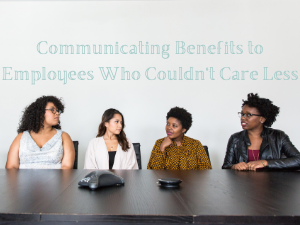You’re finishing up open enrollment, but some employees are only getting started. They stride into your office, or the HR department, requesting guidance on the process; however, their demeanor says they just want to get it over with.
Or maybe your employees aren’t participating in your benefits program as vigorously as you’d like. Even though you’re supplying benefits — such as health insurance, a 401(k) and flexible spending accounts — the program remains underutilized. You feel as though your employees don’t care.
But that’s likely not the case, as the problem often lies in poor communication.
According to a 2018 survey by the Employee Benefit Research Institute, 60% of surveyed employees say they “understand their health benefits very or extremely well.” But “when asked about non-health benefits, that number drops to 51 percent.”
The study notes that “any increase in employee understanding of benefits is welcome,” particularly because employees don’t seem to be receiving sufficient benefit education from their employers. This deficiency is often tied to a lack of effective communication on the employer’s part.
First, employee benefits can be complicated. Benefits — such as health insurance, a 401(k) and flexible spending accounts — all have different rules and regulations, including criteria for eligibility and participation. If your benefits documents and enrollment forms are too complex, it can diminish employees’ interest in the program.
Second, historically, employers make most benefit decisions for their employees. For example, employers are accustomed to unilaterally choosing their group health insurance plan without considering the specific needs of their employee population — which can cause employees to feel indifferent about the benefit.
Third, some employers rely too heavily on PowerPoint presentations or mass communications, which barely (if ever) move the needle on engagement.
Three tips for elevating your benefits communication:
- Avoid the alphabet soup of the benefits industry. Instead, keep the language simple and factual. Stick to information that you’re legally required to give and that will help your employees understand their benefits responsibilities.
- Break away from historical norms by providing benefits that fit the here and now. The current workforce is multigenerational and diverse, with people of different ages, genders, life stages, etc. One-size benefits packages and mass communication methods aren’t sufficient anymore, as employees now demand personalization. To get employees to care about their benefits, you must connect with them on a personal level.
- Employ communication strategies that cater to your audience, such as:
- Mobile technology.
- An online benefits platform.
- Surveys to better understand your employees’ benefit needs.
- Concise, well-timed messaging throughout the year.
- A mixture of presentation tools — for example, videos, texting, graphically attractive emails and educational brochures.
Of utmost importance are knowledgeable, caring and accessible benefits experts whom your employees can contact whenever they have questions or concerns.
©2021